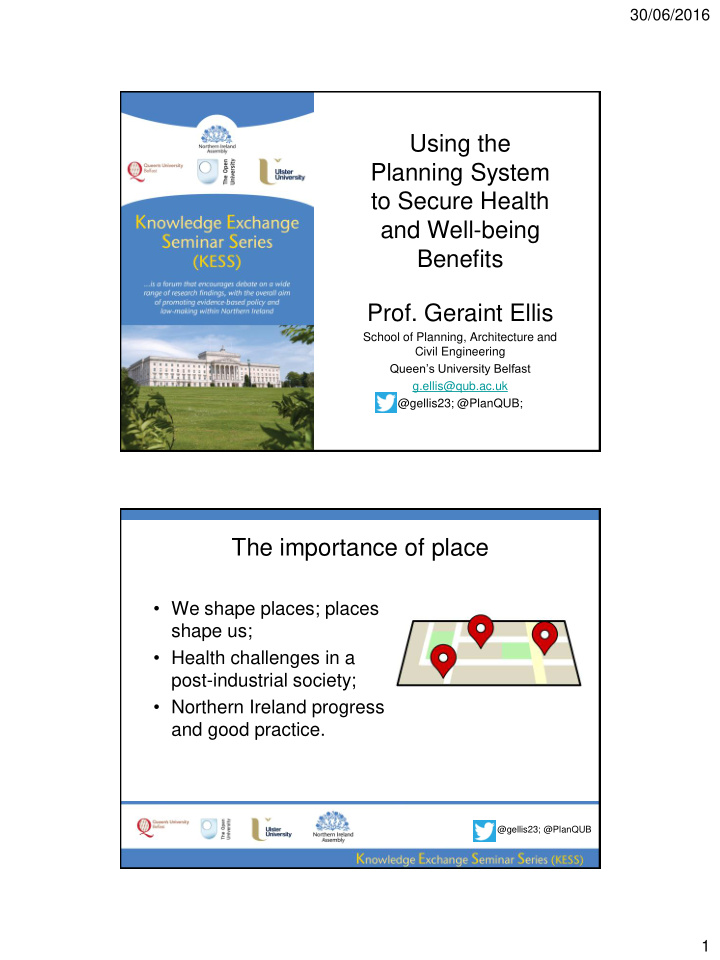



30/06/2016 Using the Planning System to Secure Health and Well-being Benefits Prof. Geraint Ellis School of Planning, Architecture and Civil Engineering Queen’s University Belfast g.ellis@qub.ac.uk @gellis23; @PlanQUB; The importance of place • We shape places; places shape us; • Health challenges in a post-industrial society; • Northern Ireland progress and good practice. @gellis23; @PlanQUB 1
30/06/2016 Burden of disease attributable to 20 leading risk factors for both sexes in 2010, expressed as a percentage of UK disability-adjusted life-years @gellis23; @PlanQUB Source, Murray et al 2013 Health: ‘ a state of complete physical, mental and social well-being and not merely the absence of disease or infirmity WHO, 1948 Well being: ‘Feeling good and functioning well’ NEF, 2008 @gellis23; @PlanQUB 2
30/06/2016 Health and the planning system • The progressive origins of the planning system; • Planning as a component of the post- war welfare state; • The rise of technical professionalism and the decline of social objectives; • Current statutory purpose: ‘to secure the orderly and consistent development of land’ @gellis23; @PlanQUB Health and the built environment • Air Quality • Obesity and inactivity • Access to open and green space @gellis23; @PlanQUB 3
30/06/2016 Source: Ferguson 2016 and SAPAS @gellis23; @PlanQUB @gellis23; @PlanQUB 4
30/06/2016 Health and the built environment • Social exclusion and poverty • Mental health • Access to health care and other services @gellis23; @PlanQUB 5
30/06/2016 Subways and train @gellis23; @PlanQUB The Poke Principle (The ‘Popsicle Test’) @gellis23; @PlanQUB 6
30/06/2016 The role of the planning system • Built environment interventions are comprehensive, long-lasting and cost effective; • Planning: • …comprehensively controls the built environment; • …takes a long term perspective; • … incorporates complexity and diversity of interests; • …is democratically controlled and participative • …is a recognised element of civilised society. @gellis23; @PlanQUB Key actions for Healthy Urban Planning 1. Make good health a statutory objective: Amend s1(1) of the NI Planning Act to: The Department must formulate and co-ordinate planning policy for securing the development of land that secures improved health and well-being for current and future generations ’ 2. Adopt a health-led planning system: • Health as a material consideration; • Public health experts in planning teams; • Health Impact Statements; • Adopting minimal standards • Training for planners and councillors; • Restricting ‘poor health’ developments; • Leading with good practice; @gellis23; @PlanQUB 3. Regulating 7
30/06/2016 NHS Healthy New Towns @gellis23; @PlanQUB Key actions for Healthy Urban Planning 1. Get serious about car dependency; • NI rates of car use and the impact of past policy; • The costs of car dependency; • Discourage car use through congestion zoning, reducing parking and ‘road diets’; • Encouraging alternatives through public transport investment, reducing car generating developments, encouraging active travel. 2. Make active travel easy: • Addressing imbalances in transport spending; • Making walking and cycling safer; • Long term strategies for towns and cities; • Incorporating cost-savings. @gellis23; @PlanQUB 8
30/06/2016 Number of new chronic diseases prevented over 40 years, if 2%, 5% or 10% of those currently inactive in the Greenway population, become active For effectiveness estimates as low as 2%, the intervention would remain cost-effective (£18 411/disability-adjusted life year). Small gains in average life expectancy and disability-adjusted life expectancy could be achieved, and the Greenway population would benefit from 46 less years lived with disability. Dallat et al 2013 Key actions for Healthy Urban Planning 1. Rediscover planning at the neighbourhood level: • Planning for a 10 min walk; • Clustering services and minimal access thresholds. • Access to schools, clinics, shops Source: Barton et al (2010) 2. Integrate environmental health with planning: Toddler’s play areas • 100m Planning as the first line of defence Allotments 200m against pollution; Playground 300m Bus stop 400m • Monitoring local environmental Local shops, pub, community centre 600m capacities; Primary School 800m Surgery 800m • Use of Strategic Environmental Playing fields 1000m Assessment and Environmental Impact Secondary School 1500m Leisure Centre 1500m Assessment. @gellis23; @PlanQUB 9
30/06/2016 Key actions for Healthy Urban Planning 1. Make places greener: • The Six Acre Standard • Minimal access thresholds to play areas, parks, playing fields… 2. Address health and environmental inequalities: • Targeting greatest need • Age- and Child-Friendly Cities • Enforcing minimal standards 3. Effective community engagement @gellis23; @PlanQUB @gellis23; @PlanQUB 10
30/06/2016 11
Recommend
More recommend